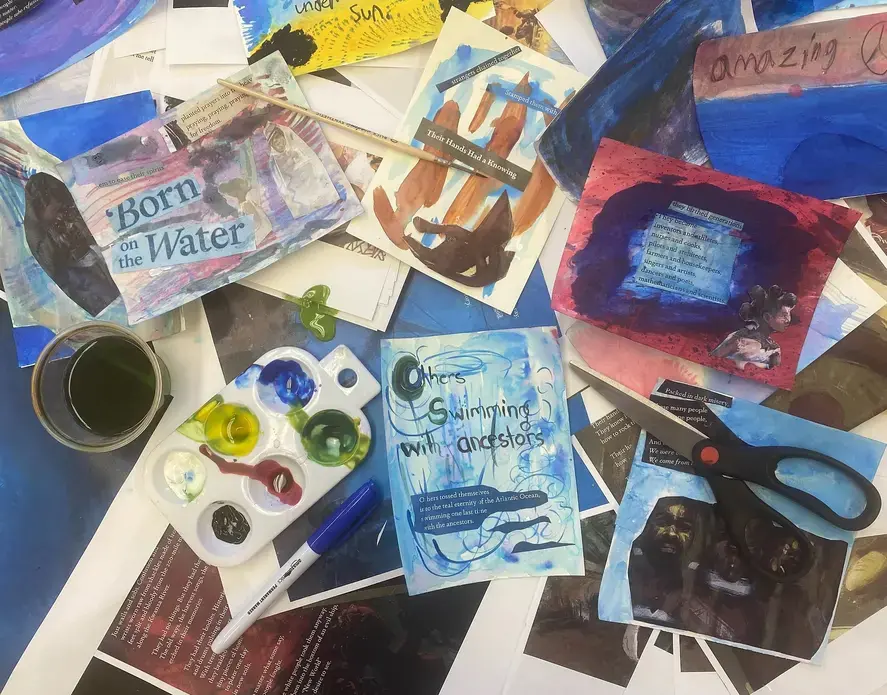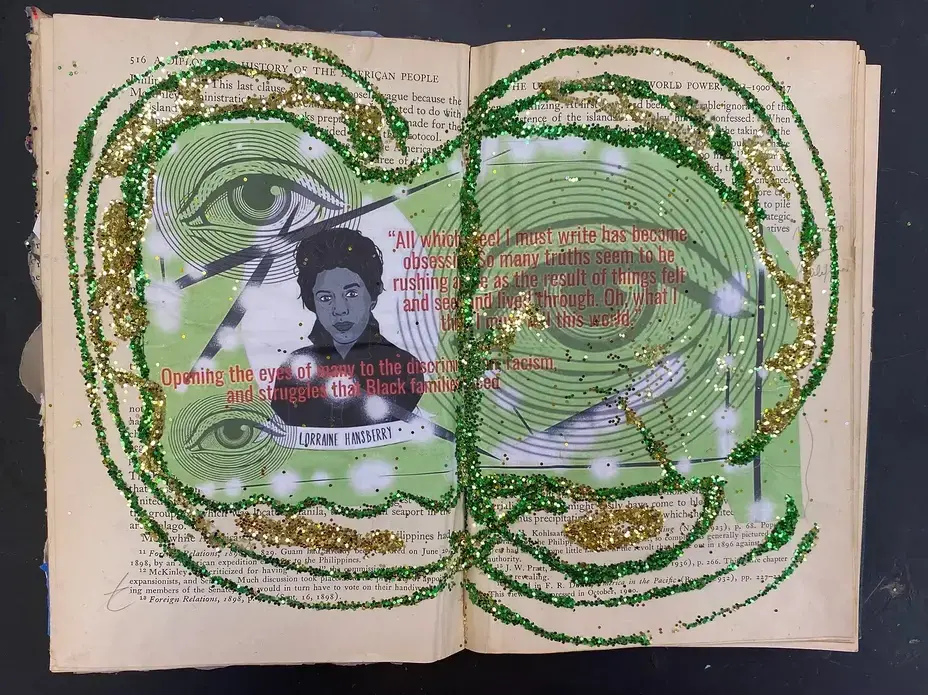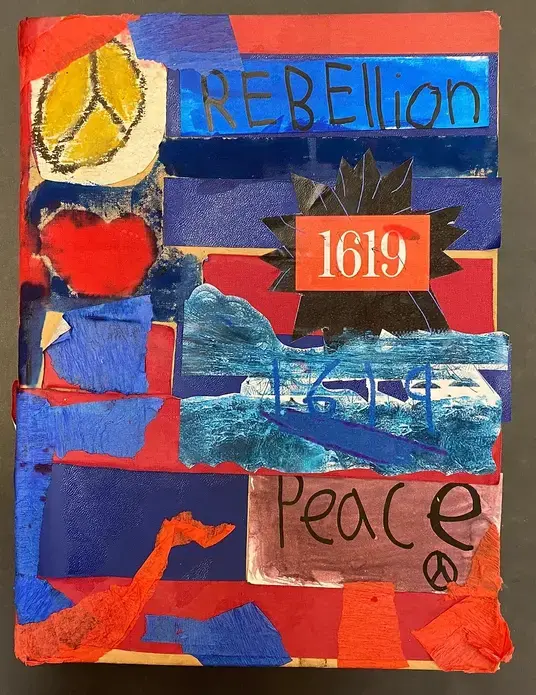This unit was created by art and English Language Arts educators in Chicago, IL, as part of the 2022 cohort of The 1619 Project Education Network. It is designed for facilitation across approximately ten weeks, or 30 class periods. It is part of a unit that includes both Altered Book-making and figurative language writing. This unit reviews lessons related to the altered book research and creation. Click here for lessons related to teaching figurative language (These will be added in early March 2023)
Objectives and Essential Questions
Students will be able to..
- Deconstruct U.S. history books to construct and altered book that tell underreported stories about the histories of American people
- Tell stories about U.S. history and their own cultural identities that integrate details and themes from "The 1619 Project" and resources by other Black cultural ambassadors
- Create art and write figurative language that expresses their cultural identities and incorporates new and developing perspectives from their learning throughout this unit.
Essential Questions:
- Who do you seek out for information, guidance, advice, and knowledge that helps you learn and discover your cultural identity? (Cultural ambassadors can be artists, dancers, musicians, actors, and writers that tell the story of different cultures through the art form.)
- Who do you seek out for information, guidance, advice, and knowledge that helps you learn and discover how your cultural identity connects to the cultural identities of others? (Cultural ambassadors can be artists, dancers, musicians, actors, and writers that tell the story of different cultures through the art form.)
- Why is it important to consider our histories and cultural narratives through a lens that applies both critical thinking and empathy? What can we gain from this practice?
- What art forms (visual and performing art and writing), artists/writers and their work serve as cultural ambassadors to help you feel most connected to and celebrate the cultures of Black Americans?
Unit Overview
As part of a collaborative art and figurative language-integrated project, students will examine connections with their cultural identity and aspects of U.S. history presented in “The 1619 Project.” They will explore how their cultural identity is informed by history, evaluate what new information they learn about their identities through engagement with “The 1619 Project and other historical resources, and ultimately deconstruct vintage books covering U.S. history in order to reflect their analyses from the unit (altered book art). Students will examine what stories have been underrepresented in U.S. history books by exploring news articles, primary sources, storytelling, and artwork. They will practice persuasive writing and creating writing skills, and will also develop and deepen emotional literacy, empathy, and critical thinking skills. Their finished work will construct a more inclusive and accurate history of the American People that, in turn, informs their cultural identity. Students will then decide how they share their work with others.
This project is grounded in a continued commitment to seek truth and reconciliation for historically marginalized communities. The project explores the healing power of bearing witness to the accurate history of others and guides students in developing an intentional understanding, empathy towards others, synthesizing of differences, and exploring opportunities for authentic belonging in the social setting of schooling.
The full project is intended to be taught in the art classroom, and students’ home classrooms. The project also provides individual and co-teaching opportunities.
Themes:
- Deconstruction and Reconstruction
- Cultural Identity
Art skill practiced: Deconstructive and Constructive art making, Collaborative skills, Composition skills, Drawing, Painting, Printmaking, and Collage
Figurative Language Skills practiced: Deepening descriptions, heightening the impact of ideas, emphasizing a point or idea, improving understanding by making comparisons, and heightening impact of language.
Scope and Sequence:
- Investigate Cultural Differences
- Understand the impact of historical erasure
- Develop an equitable lens to understand histories of people in America
- Deepen Understanding of Cultural Identity
- Investigate resources from “The 1619 Project”
- Make connections between art and storytelling
- Investigate how art can serve as a cultural ambassador and inform American History
- Explore emotional literacy through engagement with The 1619 Project
- Reading of Born on the Water by Nikole Hannah-Jones, Renée Watson, Nikkolas Smith
- Incorporating “The 1619 Project” themes and resources into Altered Book Creation
- Incorporating Cultural Ambassadors into Altered Book
- Incorporating Persuasive writing into our Altered Books
- Culminating Project: Students share their American History Altered Books
Performance Task
Culminating Project: Students will be deconstructing, and then reconstructing, U.S. history books that they believe do not provide an accurate and inclusive history using an art form called “Altered Books.” By the end of the unit, students will use creative writing and original art to integrate essential historical information they have researched, and that they feel was missing, into the U.S. history books to include their learning and perspectives throughout this unit.
Students use the following resources to prepare for the project:
Altered Book project introduction
Altered Books Planning Sheet [.pdf] [.docx]
As part of developing this project, students will discover how stories are told through visual art, performing art, and writing. They will identify details from unit resources to include in their projects. They will also research the work of Black artists and writers who are documenting history in order to identify additional stories and resources for their altered books. For example, students will look at the work of Kerry James Marshall and his art about the experiences of Black Americans. Students will ultimately have the opportunity to add information from these artists, and their own art and writing, into the altered U.S. history book. The students will also decide where their altered history book will belong (school library, local library, city hall, or any other location they would like). The guiding question throughout this unit will be: How can we learn about the stories that have been erased in U.S. History to continue on the path of truth and reconciliation and further our commitment to keep learning about marginalized communities?
Students also engage in this unit by completing reflective mini lessons that deepen their knowledge about “The 1619 Project.”
Assessment/Evaluation
Assessment Goals:
- Based on specific learning targets and success criteria
- Designed by teachers and students
- Elicit evidence of student learning
- Informs instruction
- Involves students
- Provides specific, actionable, and immediate feedback
Formative Assessment CATs (Classroom Assessment Techniques: [.pdf]
Classroom Assessment Techniques (commonly called CATs) are brief instructor-led activities designed to help shape and focus subsequent teaching, based on students’ current understanding and ongoing learning needs. Most take only a few minutes of class time and can be used repeatedly throughout the assignment. CATs are an easy way to assess how well students are learning content. Furthermore, they allow students to monitor—and quite possibly strengthen—their own learning.
Several stages during the assignment, students will complete a CAT with the goal of answering for the students:
- Where am I going?
- Where am I now?
- How do I get from here to there?
Students will evaluate their altered books using the following resources:
Self Assessment Checklist [.pdf] [.docx]
Student Created Rubric Example [.pdf] [.docx]
Student Created Rubric Guidelines
Template Student Created Rubric [.pdf] [.docx]Formative Assessment Figurative Language: pre and post assessment [.pdf] [.docx]
30-lesson unit plan for teachers, including pacing, texts and multimedia resources, guiding questions for group discussions, and performance tasks for the unit. Download below, or scroll down to read the complete unit plan. The accompanying unit plan that outlines the figurative language lessons that support the performance task in this unit will be published in early March 2023
| Texts: | Full PDF of New York Times Print Magazine: “The 1619 Project” Here Broadsheet from The New York Times with primary source documents and artifacts curated by Mary Elliott, curator at the Smithsonian’s National Museum of African American History and Culture: Here Interact with the original 1619 Project in a dynamic way on the NYT Magazine website A K-8 section of the The New York Times about the lasting impact of slavery in the United States Here Born on the Water by Nikole Hannah-Jones, Renée Watson, Nikkolas Smith Educators Guide: Born on the Water Here Iraq: The Journey Home by Zahra Ahmad and Brontë Wittpenn for MLive Definitions of “erasure” Here and Here Cultural Identity Definitions and Reflection Questions” [.pdf] [.docx] Queen Nzinga Student Study Here and Here (page 5) |
| Additional Resources from Pulitzer Center and “The 1619 Project” |
Teaching “The 1619 Project” from the Pulitzer Center Here Virtual Journalist Visit to your classroom sign up Here “The 1619 Project” elementary Pulitzer Center-supported resources Here “Teaching Black History to Elementary and Middle School Students” webinar with Nikole Hannah-Jones and Dr. LaGarrett King Here 16 writers bring consequential moments in African-American history to life as part of The 1619 Project Here “The 1619 Project” Podcast Listening Guide Here The New Origin Story: The 1619 Project Here (Information about the author and illustrator of Born on the Water) The K-12 Curriculum Guide: “The 1619 Project” books Here |
| Teaching Materials: | Art Teaching Resources: [.pdf] [.docx] Figurative Language Resources: [.pdf] Similarities and Differences worksheet Similarities and Differences Worksheet_Research Expanding our Connections to the World [.pdf] [.docx] Vocabulary 1 [.pdf] [docx.] Digital Example Elements of Culture Dominant Culture Definition Example Difference worksheet Here Erasure Definition and Impact [.pdf] [.docx] The Journey Home Reflection questions [.pdf] [.docx]. Week 2, Lesson 2_Vocabulary. [.pdf] [.docx Cultural Identity Definitions and Reflection Questions [.pdf] [.docx] Resource Here from Unite for Sight to support discussions about cultural identity Vocabulary 3_week 3_Lesson 1 [.pdf] [.docx] History Teachings Reflection Here Vocabulary 4 [.pdf] [.docx] Vocabulary 5 [.pdf] [.docx] Historical Terms to prepare for understanding. [.pdf] [.docx] Altered Book project introduction |
Social Justice:
Social Justice Standards Here
- Identity 3 ID.3-5.3 I know that all my group identities are part of who I am, but none of them fully describes me and this is true for other people too.
- Diversity 10 DI.3-5.10 I know that the way groups of people are treated today, and the way they have been treated in the past, is a part of what makes them who they are.
- Justice 15 JU.3-5.15 I know about the actions of people and groups who have worked throughout history to bring more justice and fairness to the world.
- Action 20 AC.3-5.20 I will work with my friends and family to make our school and community fair for everyone, and we will work hard and cooperate in order to achieve our goals.
Visual Art:
Visual Art Standards Here
- Apply knowledge of available resources, tools, and technologies to investigate personal ideas through the art-making process.
- Investigate and discuss possibilities and limitations of spaces, including electronics, for exhibiting artwork.
- Identify and explain how and where different cultures record and illustrate stories and history of life through art.
- Determine messages communicated by an image.
- Evaluate an artwork based on given criteria.
- Develop a work of art based on observations of surroundings.
English Language Art Standards/Writing:
Writing Standards Here
- Introduce a topic and group related information together; include illustrations when useful to aid comprehension.
- Develop the topic with facts, definitions, and details.
- With guidance and support from adults, produce writing in which the development and organization are appropriate to task and purpose. (Grade-specific expectations for writing types are defined in standards 1-3 above.)
- Conduct short research projects that build knowledge about a topic.
Before there was one story, now there are many stories about people who were enslaved and resisted."
EE, Third grade student in Chicago, IL
Students start the unit by creating and analyzing definitions for culture. Below are examples of drawing created by students to reflect their cultures.
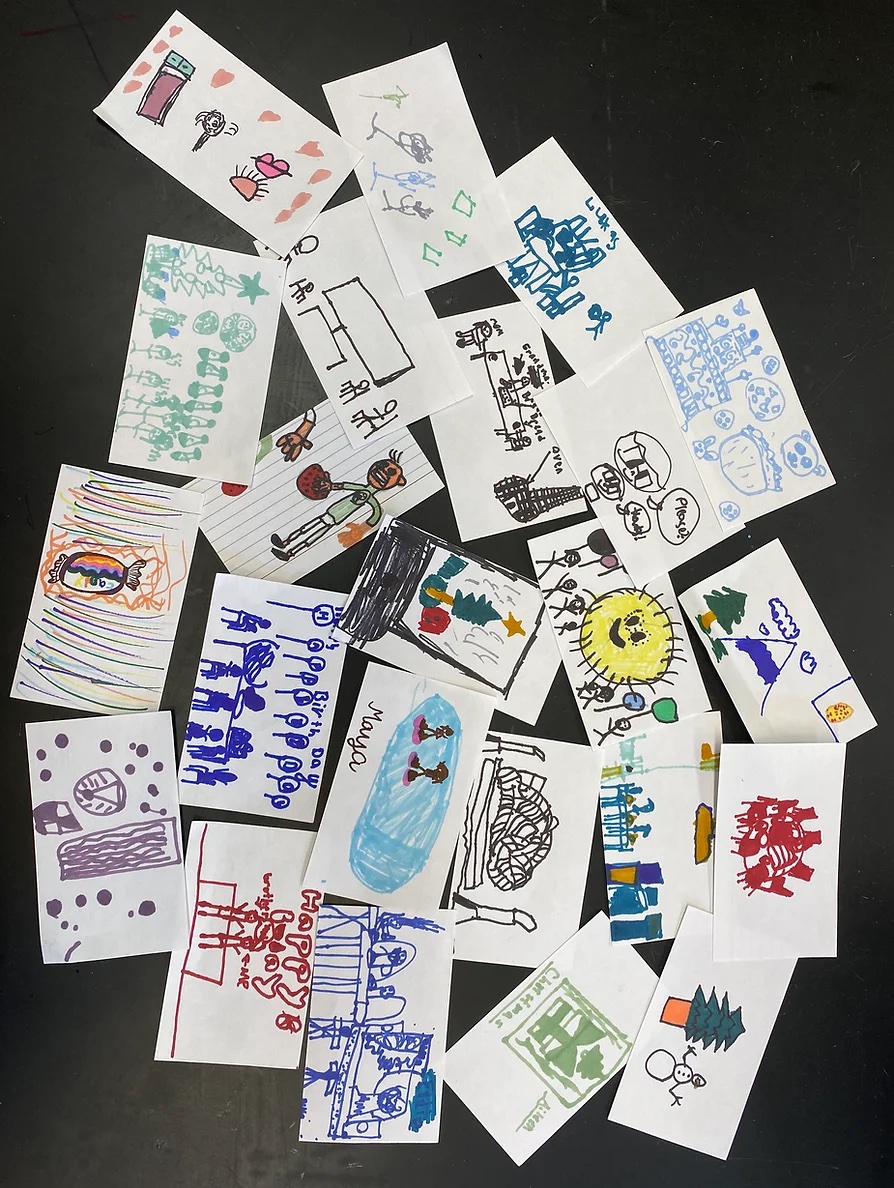
Students then created definitions for "dominant culture" and reflected on how their cultures are similar and/or different from how they have defined "dominant culture." Click here to see examples from student reflections in fall 2022.
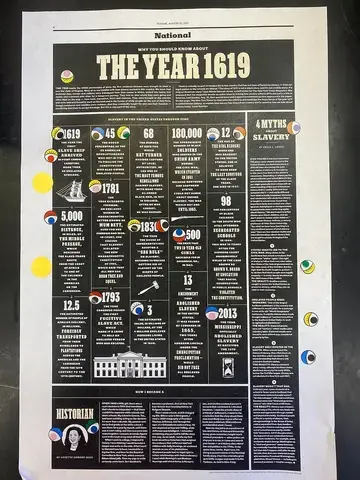
After that, students engaged with resources from the Pulitzer Center, "The 1619 Project" from The New York Times, and other historical resources to explore what stories are underrepresented in the teaching of U.S. history. The following resources reflect examples of students' analyses of these resources:
- Student Example of reflections about Queen Nzinga Here
- Reflection of the 4 Common Myths of Slavery from The 1619 Project (questions and student example)
- Student Sample of reflections on the project, "The Journey Home" fro MLive about journalist Zahra Ahmad's trip to Iraq to reconnect with her family Here
- Example of Student Questions for the journalist Zahra Ahmad and her responses
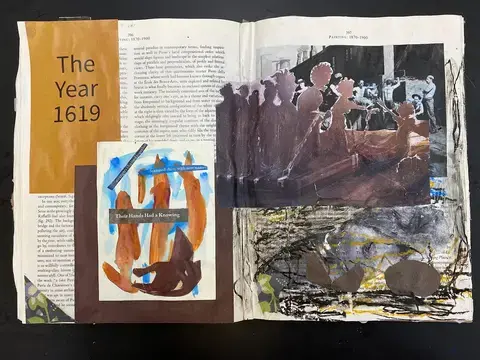
By the end of the unit, students synthesize their learning by creating Altered Books that reflect stories they feel are underrepresented in the teaching of U.S. history. The following are examples of students' final books. Click here to see more examples!


